- Biotech stocks have turned the corner, moving forcefully higher, but they still have a long way to go after deeply lagging the market.
- The overarching systemic risk of a growing shift towards regulation and possible industry restructuring will remain
- However, a window of opportunity has emerged for healthcare and biotech stocks to participate in the market rally
- RNA stocks are becoming more noticeable as the field has significantly advanced over the last two decades and is now beginning to deliver breakthrough successes.
- RNA editing, like DNA editing, is also a gigantic opportunity, with new drug advances, multi-billion-dollar partnerships, and potential for acquisitions
Biotech Pulse

Biotech finally has a pulse.
The improving appetite for risk has resuscitated the moribund biotechs and pharma (biopharma) groups. The Nasdaq Biotech (IBB) and the S&P Biotech (XBI) indexes have begun their advance from their year-to-date lows recorded earlier in October. The sector dynamics have not shifted meaningfully and the overarching risk of regulation persists. But with the growing market shift towards embracing risk, the biotechs will rise with the broader market and there is a window of opportunity for meaningful gains, as strongly highlighted in the earlier article Healthcare And Biotechs Struggle, But Opportunity Ahead.
The healthcare overhaul and uncertainty will remain an ongoing theme until the elections, leading to higher volatility and capping any gains. That’s why we had referred 2019 as a Biotech Uphill Battle. Nonetheless, with this emerging window of opportunity, we wanted to highlight a few biotech companies in the highly promising RNA segment.
RNA – Coming Into Its Own
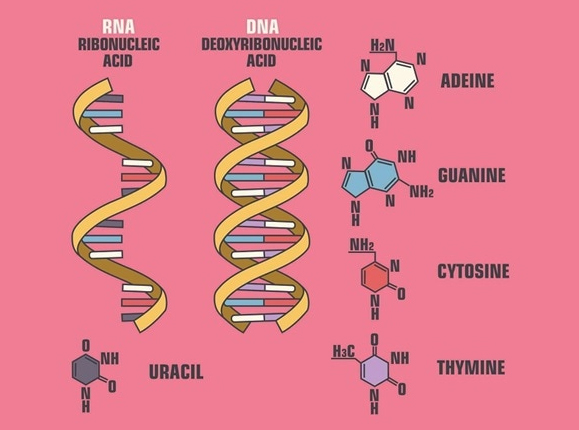
There have been many companies toiling in the RNA space for the last two decades. The results are beginning to come through more frequently and consistently.
A basic background for understanding RNA will be helpful. Like its more well-known cousin Deoxyribonucleic acid or DNA, which contains the genetic code for creating proteins, the Ribonucleic acid or RNA also performs a critical function to unlock and sustain life. An enzyme translates the genetic code or protein-creating instructions from the DNA into a message which is transported to the appropriate protein-manufacturing location (ribosomes) in the cell. The message with the instructions is called the RNA or messenger RNA (mRNA). The proteins, which have seemingly endless functionality, are considered the building blocks and provide the body structure, function, and regulation of the body’s tissues and organs, including the brain. Now, if the protein-making instructions that the RNA carries are altered, one can begin to have an impact on how the protein is manufactured or not manufactured when it arrives at the ribosomal protein-making factories, and what characteristics it manifests, thus providing a pathway to potentially address a wide range of debilitating diseases.
Many diseases are caused by defective genes or improper protein-making instructions from the DNA, which can result in the production of faulty protein mutations – toxic or non-functional or not sufficiently powered or over-powered. In 1998, biologists Andrew Fire (Carnegie Mellon) and Craig Mello (University of Massachusetts) discovered the process of RNA interference or RNAi in which a double-stranded RNA (dsRNA) can be used to turn off specific genes using an altered code sequence. The discovery, for which the two biologists received a Nobel prize in 2006, set off a revolution in the advancement of RNA science. RNAi is the naturally occurring cellular mechanism or process in living cells by which the RNA molecules inhibit gene expression or translation, by neutralizing or modifying the mRNA molecules, thus regulating the production of the specific proteins. The powerful approach can silence any errant gene in the human genome. Most companies in the RNA space are focused on developing therapeutics leveraging this natural pathway of gene silencing.
Science and genetic breakthroughs have advanced to a point where therapeutic tools are available to correct the mutations at the genetic roots through DNA or RNA correction, by either activating, silencing, editing or replacing the incorrect instructions. There are variants of RNA-based therapies, like RNAi, and small interfering RNA (siRNA), which are the smaller fragments of the long double-stranded RNA when they are diced. There is also the antisense approach in which single-strands of nucleic acids bind to the RNA to modify their expression.
Numerous biotech and large pharma companies are working on developing the promise of RNA. Pioneering work over the last 25 years and recent successes have significantly elevated investor interest. A few RNA-therapeutic companies include Alnylam Pharmaceuticals (ALNY), Moderna (MRNA), Ionis Pharmaceuticals (IONS), Arrowhead Pharma (ARWR), Dicerna Pharmaceuticals (DRNA), Crispr Therapeutics (CRSP), Voyager Pharmaceuticals (VYGR), Akcea Therapeutics (AKCA), Intellia Therapeutics (NTLA), Precision Biosciences (DTIL), Translate Bio (TBIO), BioNTech (BNTX). Four of them are highlighted below.
Alnylam Pharmaceuticals (ALNY)
Alnylam has been one of the leaders in RNA therapies and last year claimed the crown for the first-ever approved RNAi based therapy. The company’s drug, Patisiran (trade name Onpattro), is a fatal rare disease treatment that is the first gene-silencing siRNA drug approved by the FDA. The drug interferes with the production of an abnormal form of protein.
Alnylam has a broad pipeline with programs in rare genetic, cardio-metabolic, hepatic infectious, and central nervous system diseases.
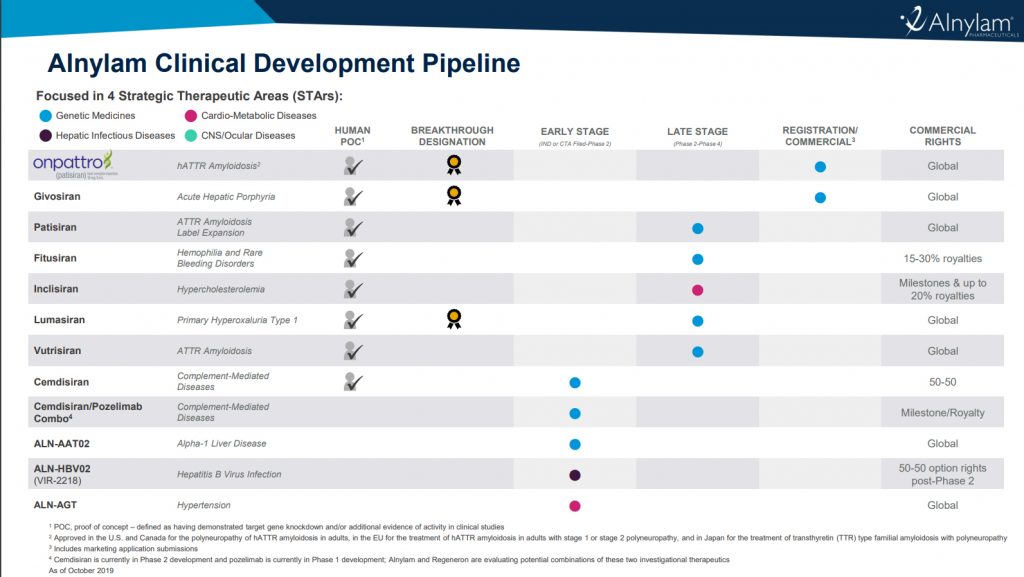
Alnylam has an RNA drug discovery platform and a deep pipeline of products in various stages of development, including 3 fully owned products in Phase-3. In September 2019, its cardiovascular product for hypercholesterolemia targeting the low-density cholesterol reported strong Phase-3 data. The product, Inclisiron, is globally licensed to The Medicines Company (MDCO), which is responsible for its development and commercialization. Inclisiran is the first cholesterol-lowering therapy in the siRNA class, and after The Medicines Company reported strong Phase-3 data, the drug should most likely become the first approved one in its class.
The Company’s next product, Givosirian, met its primary endpoint for a rare disease and has a PDUFA date of February 4, 2020. The Vutrisiran Phase-3 study for Hereditary Amyloidosis patients is now enrolling, while a second Phase-3 study for Amyloidosis patients with Cardiomyopathy will initiate towards the end of this year. So from a regulatory standpoint, Alnylam has the most advanced candidate pipeline.
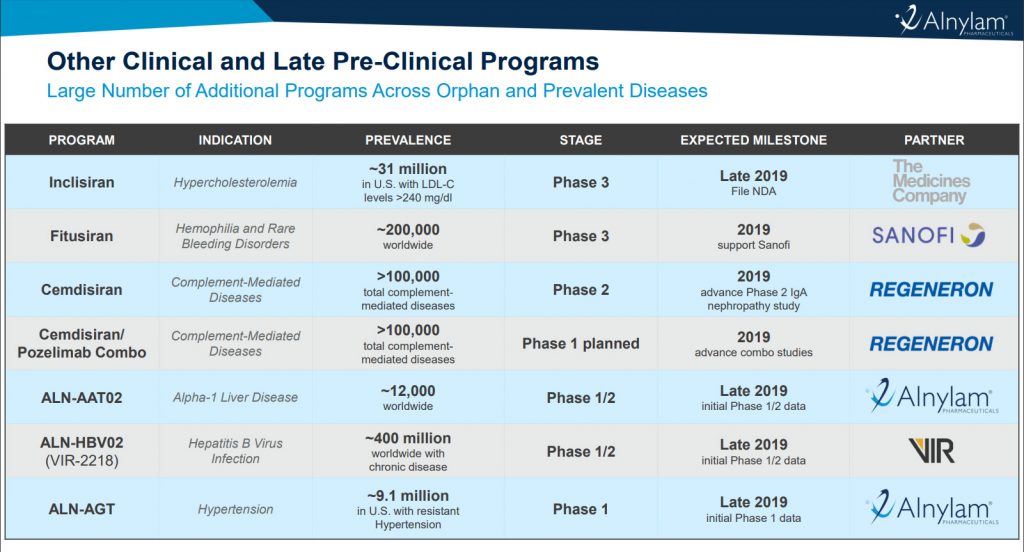
The Company had cash and short-term investments balance of $1.9 billion at the end of June 2019. With a market cap of nearly $10 billion, Alnylam is the largest RNA focused company.
Moderna (MRNA)
Moderna is one of the leading RNA focused companies, with a platform focused on drug discovery and development by advancing the mRNA science. The Company has a broad pipeline interest with therapeutic and vaccine programs in infectious, immuno-oncology, rare, and cardiovascular diseases.
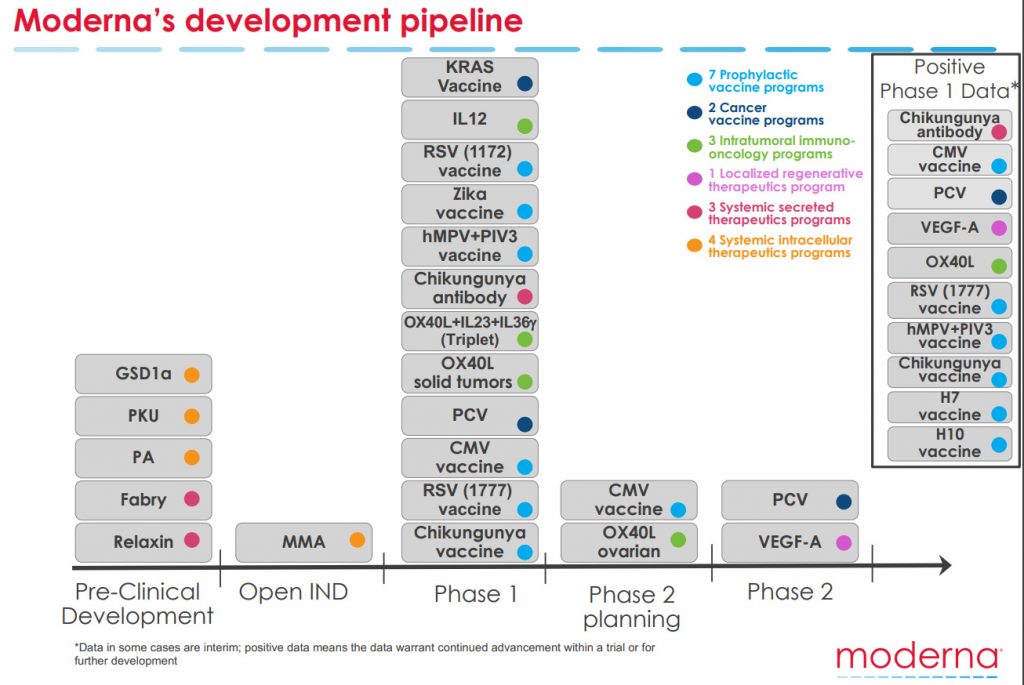
Moderna has the largest vaccine program based on mRNA science. The messenger RNA can easily mimic the natural infection to trigger a potent immune response, which makes it amenable for vaccine development.
The most advanced vaccine programs are the congenital Cytomegalovirus or CMV vaccine and the ovarian cancer vaccine. Cytomegalovirus is the most common infectious cause of birth defects and brain damage in newborns. The CMV vaccine program is progressing into Phase-3 to demonstrate the prevention of CMV infection in an ~8,000 participant study of healthy women. The Company’s thrust is on these innovative vaccine programs, which can be a tremendous commercial opportunity if they succeed.
The Company had cash and short-term investments balance of $1.4 billion at the end of June 2019 and has a market cap of ~$5.5 billion, which makes it one of the leading RNA companies in terms of valuation.
Arrowhead Pharmaceuticals (ARWR)
Arrowhead is developing therapies leveraging its RNA-driven platform. The Company uses its Targeted RNAi Molecule or TRIM platform to discover and develop a broad portfolio of drugs, which use RNAi to silence errant genes to achieve durable cures to malignant diseases. It has a broad pipeline with 2 drugs well into Phase-2.
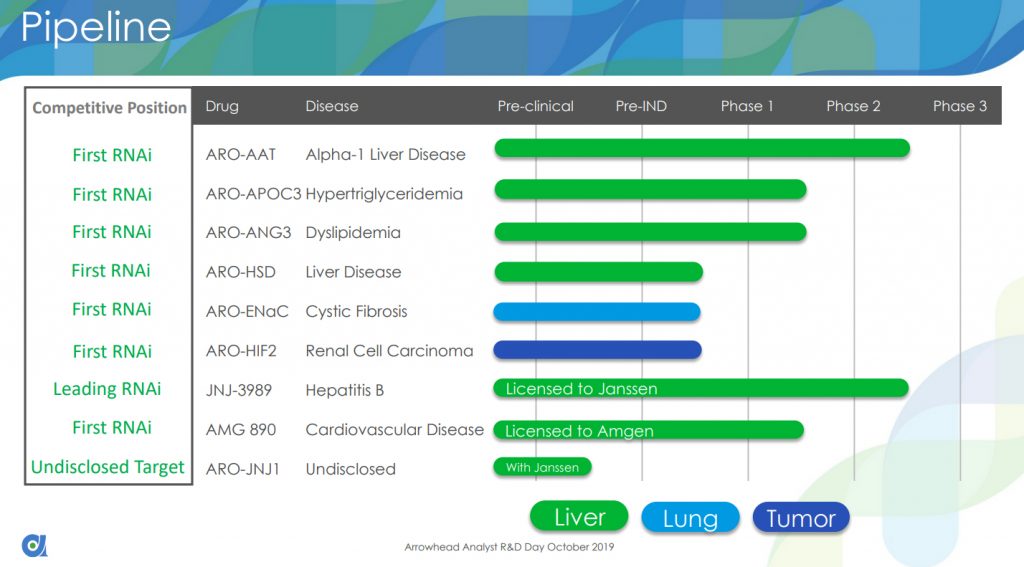
Arrowhead’s drug discovery platform enables it to scale its pipeline quite rapidly, and the Company expects to discover and advance 10 TRIM enabled clinical candidates in 2020. The Company currently has partnerships with Janssen and Amgen, which are eligible for up to $4 billion in potential milestone payments. Arrowhead has disclosed that it is not focused anymore on further partnering on its existing pipeline, but is open to such collaborations on new targets. By the end of 2020, the Company expects to have three Phase-3 studies of fully-owned assets.
Arrowhead had ~$235 million in cash equivalents and short-term investments at the end of June 2019 quarter and has a market cap of ~$3.8 billion.
Dicerna Pharmaceuticals (DRNA)
Dicerna is also a platform-based company developing therapeutics using RNAi to silence disease-causing genes. The Company uses its GalXC platform to discover treatments in the chronic liver, cardiovascular, neurodegenerative, rare, and viral liver infectious diseases.
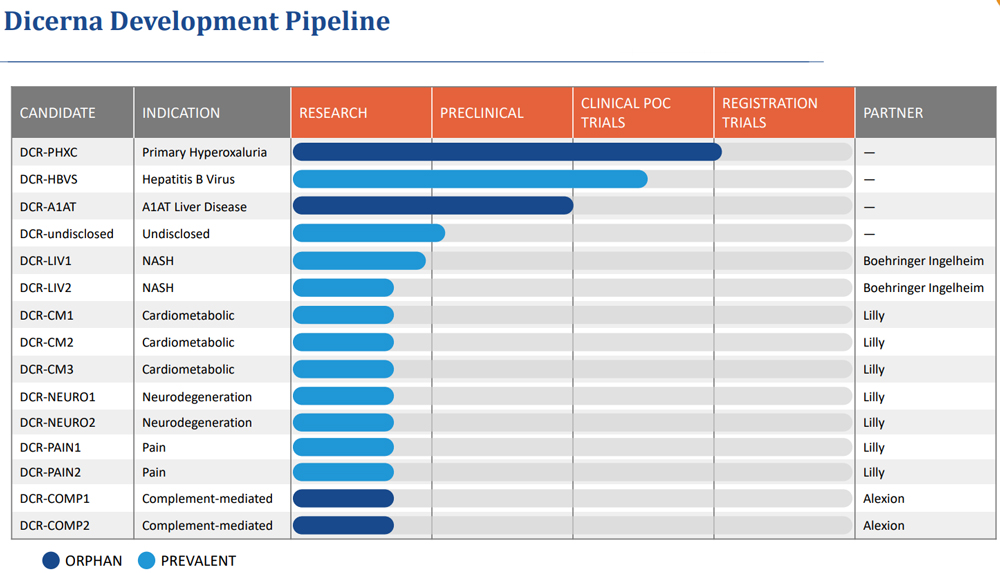
The Company’s leading product is for Primary Hyperoxaluria disease, which is a rare and inherited metabolic disorder in the liver. The drug has advanced to the Phase-2 trial. There are several early opportunities in which Dicerna has stated its intent to partner and it did so last week for one of its programs. Dicerna has a chronic Hepatitis B drug development program, DCR-HBVS, in Phase-1 for which it partnered with Roche last week, receiving an upfront $200 million payment and potential milestone payments that can approach $1.5 billion. The collaboration includes the discovery and development of additional therapies targeting additional human and viral genes associated with the HBV infection. The Company has additional partnerships with Eli Lilly (LLY), Alexion Pharmaceuticals(ALXN), and Boehringer Ingelheim.
Dicerna had cash and equivalents of $340 million at the end of June 2019 and has a market cap of ~$1.1 billion.
Conclusion
As the Fed has lowered interest rates, and it’s clearer the economy is not close to a recession, there has been an expansion of risk appetite. The US-China trade friction is in a short-term truce mode which has helped considerably as well. In this favorable environment for stocks, biotechs will also benefit from an improving desire for risk-taking. Furthermore, there appears to be an uptick in biotech transactions and partnerships. Just in less than 2 months, there have been $9 billion of transactions involving purchases of smallcap biotechs. These include acquisitions of Alder Pharmaceuticals (ALDR) by Danish firm Lundbeck (OTC:HLUKF), Dova Pharmaceuticals (DOVA) by Swedish firm Orphan Biovitrum (OTCPK:BIOVF), Ra Pharmaceuticals (RARX) by Belgian firm UCB (OTCPK:UCBJF), Achillion Pharmaceutical (ACHN) by Alexion Pharmaceuticals (ALXN), and privately held Semma Therapeutics by Vertex Pharmaceuticals (VRTX).
While healthcare, particularly biotechs and pharmaceuticals, has been hurt by regulation uncertainty, investors are now presented with a window of opportunity to buy into an oversold group. The overarching concerns about healthcare restructuring and regulation will persist. But for now, biotech investors are presented with a favorable opportunity to benefit from recent declines which have been mostly due to systemic factors.
Also, as we pointed out earlier, biopharma declined in September were sharply due to the ascendancy in the polls of Senator Warren, who has a Medicare for All plan that calls for a greater restructuring of the healthcare industry. To the extent that Senator Warren begins to lose her lead in the polls or modifies her healthcare plan to lower its impact, depressed valuations for biotechs and pharmaceutical companies will spring higher.
The biotech investors have many attractive candidates. A few such names, which may be now or in the past part of the Prudent Biotech model portfolio or the Graycell Small Cap portfolio, include Medicines Company (MDCO), Acadia Pharmaceuticals (ACAD), Alnylam Pharmaceuticals, Arrowhead Pharmaceuticals, Reata Pharma (RETA), Moderna, Seattle Genetics (SGEN), Dicerna Pharmaceuticals, Momenta Pharmaceuticals (MNTA), Deciphera Pharmaceuticals (DCPH), Apellis Pharmaceuticals (APLS), Zymeworks (ZYME), Karyopharm Therapeutics (KPTI), Aimmune Therapeutics (AIMT), Arqule (ARQL), Radius Health (RDUS), Flexion Therapeutics (FLXN), Assembly Biosciences (ASMB), Kodiak Sciences (KOD), Optinose (OPTN), Mirati Therapeutics (MRTX), Revance Therapeutics (RVNC), Tricida (TCDA), and Iovance Biotherapeutics (IOVA).
For a further understanding of RNA, there are many resources and one such resource is Professor Mello’s Medical School at the University of Massachusetts.
The article was first submitted on Nov 1, 2019 on Seeking Alpha
As always, kindly do your own due diligence. Although there are no personal positions, stocks mentioned can be part of the portfolios of family and associates.
Graycell Advisors (GraycellAdvisors.com) or Prudent Biotech (PrudentBiotech.com) or associated names and entities are not a registered investment advisor (RIA) and publishes quantitative-driven model portfolios for investors and RIAs. Some or all of the companies/stocks mentioned in the article may be in the past, now, or in the future, be part of the various model portfolios for subscribers. Past performance is not a guarantee of future results. The information here is only provided for a general informational purpose and not as a recommendation, and is not guaranteed to be complete or accurate.
The biotechs and the small-cap/early mid-cap market segments carry a higher risk of losses than the broader market. Opinions can change with time and additional data, with no obligation to update. Companies mentioned here may not be favored in the future as market trend changes and/or new information emerges, and no relevant portfolio updates will be provided unless you are a model portfolio subscriber.
